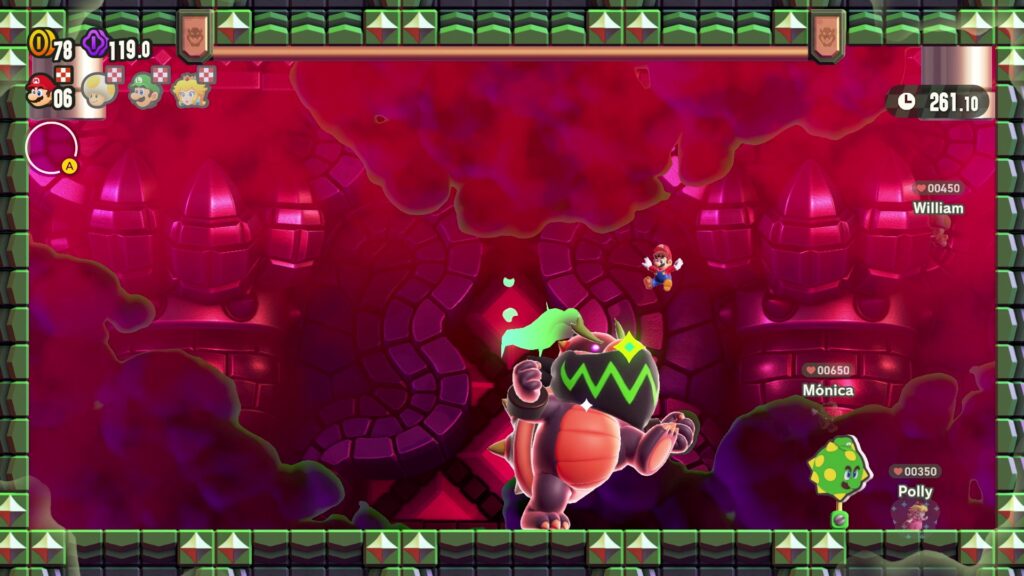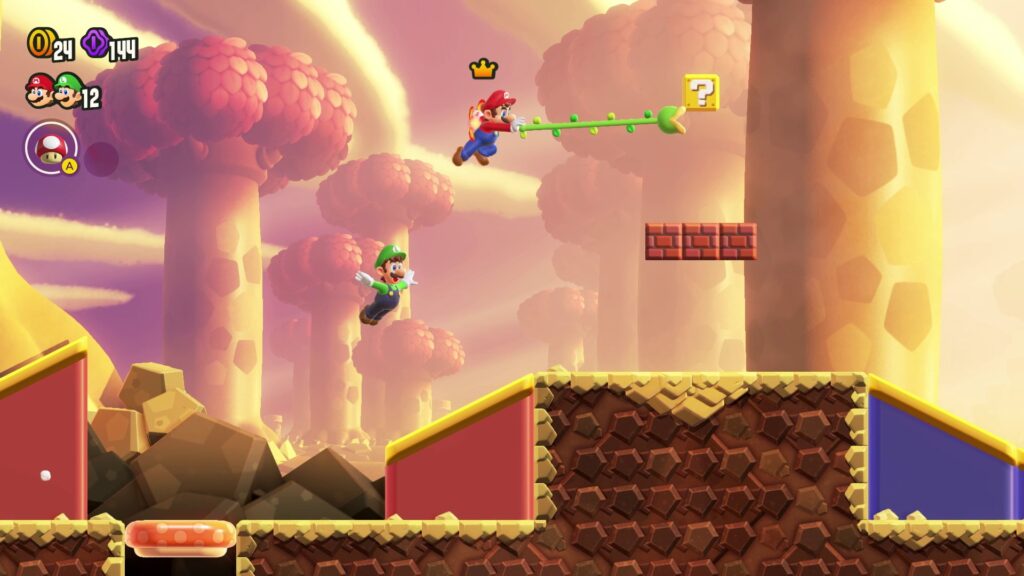I’ve been watching Super Mario Bros. Wonder very closely. While 2D Mario games have been entertaining, they’ve been mostly forgettable. There hasn’t been a lot of innovation or changes to the formula over the years.
The Super Mario Bros. Wonder Direct and the time I spent hands on with the demo at PAX Aus had me excited for the latest entry in this series. The art, sound and direction are different to what we’d seen in a Mario game before.
I’ve spent the weekend diving into Super Mario Bros. Wonder and have some thoughts.
Iconic Sounds Of Super Mario Bros. Wonder

Mario games have always had iconic sounds and music, but I wasn’t prepared for how much this game turned that up to 11. The soundtrack to the levels is memorable and got me bopping.
The musical magic isn’t just limited to the background. A few times I triggered full-on choreographed singing and dancing routines from enemies. Killing enemies during these sections will remove their ‘voice’ from the singing. That caused me to take a more pacifist approach to these sections so I could enjoy the show.
Some levels took on a rhythm aspect. Jumping in time with the music caused special things to happen, letting Mario jump higher or triggering other localised events.
Music wasn’t the only thing that drew my attention. Sound effects had received a glow-up. From small things like ground pounding getting a little drum roll or the sound of the popcorn-like enemy popping, the sound design of Super Mario Bros. Wonder stands out.
Varied Levels

Each of the seven worlds (plus special world) have a theme and individual levels will have their own flavour. There are ‘traditional’ levels for the old school Mario experience. These are joined by other, shorter levels.
Break Time stages are short, with usually only one trick needed to finish it. KO Arena is a gauntlet of enemies. Badge Challenges are special levels to teach players about the various badges (I’ll get to them later). And Search Party had me searching for five tokens to earn a Wonder Seed (read on for more about them).
These are great interludes, although the Search Party levels can get tedious. I had the most success in them playing in online mode, with the ghosts of other players helping each other find the tokens.
One of the most enjoyable moments in Super Mario Bros. Wonder was the feeling of discovery. Levels have a ton of hidden things, whether it be simply coins or something more important. Each level has large flower coins to find, and traditional stages have a Wonder Flower, which has various effects. Some levels even have multiple exits, rewarding players that explore every nook and cranny.
The Powerups

In addition to the returning Super Mushroom and Fire Flower, Super Mario Bros. Wonder features three new powerups: the Elephant, Bubble and Drill powerups.
Continuing the trend of powerups that turn Mario into an animal, the Elephant powerup feels like it has the least utility of the new abilities. While it has the most it can do, it doesn’t feel very useful. Swiping enemies with a trunk or flinging water about is fun but can be risky with players needing to get close to enemies to affect them. Elephant Mario can break through bricks with his trunk but levels that feature this powerup are designed around it with many of the bricks producing coins and resulting in a block that Mario can’t destroy.
The Bubble powerup allows for a few different talents. When most enemies run into the bubbles, they become trapped and turn into a coin. Bubbles can be shot through walls, making it ideal for tackling enemies from afar. They can also be used for platforms, allowing Mario to jump on them once before popping.
The Drill powerup gives Mario versatility by allowing attacks from below due to its pointed nature. It also gives Mario the ability to tunnel into certain floors and ceilings. He can then emerge onto enemies or certain blocks to eliminated them.
Mario can hold a powerup in reserve and call on it at will. Early in the game I was tempted to hold a different powerup in reserve to that I was currently using but levels are designed with a certain powerup in mind. There was more benefit holding that level’s powerup in reserve in case I took damage.
The Wonder Flowers

Hidden in each level is a Wonder Flower. In what has been described as Mario’s years of mushroom usage catching up with him, the Wonder Flowers cause levels to change in weird and amazing ways.
Players can not get the Wonder Flower and play through the level normally, but the effects alter things in a way that provides unique gameplay experiences. Will the pipes come to life and start crawling? What about those bones coming to life as a dragon for Mario to ride? Want to turn the game into a top-down adventure? All these things are possible with the Wonder Flower.
Controls can vary in these sections, providing fantastical sections where anything is possible.
The Badges

A new feature for Super Mario Bros. Wonder is the badge system. Before entering a level, Mario can select a badge that influences how the level plays out. These are grouped into Action Badges, Boost Badges, and Expert Badges.
Action Badges allow Mario to perform certain actions. The earliest Action Badge available is the Parachute Cap that allows players to glide through the air. Later, the Dolphin Kick badge is acquired, giving Mario a burst of speed in water. I personally liked the Wall-Climb Jump badge that gave Mario one vertical jump while on a wall.
Boost Badges provide a passive bonus. These include starting a level with a certain powerup, a magnet to draw coins to Mario, along with a sensor to let players know when secrets are near.
Expert Badges provide an extra challenge for those that seek it. These turn on modifiers like always running or turning Mario invisible.
Badges can be earnt from Badge Challenge levels or purchased through Poplin Shops using flower coins.
The depth provided by the badge system surprised me. While I stuck with the Wall-Climb Jump badge, there were occasions when I switched to the Auto Super Mushroom Boost Badge. This provided me with a small edge and let me get a level’s recommended powerup early on.
There were a few badges that became available very late in the game. This made them feel less useful than others as they took time to learn, and I was comfortable with the badges I had been using.
Online With Super Mario Bros. Wonder

I’m not sure what I was expecting from the online system in Super Mario Bros. Wonder, but I didn’t expect it to be so friendly. While the online mode is active, I was able to see other player’s live ghosts. I could see where they were heading and where they had left Standees, (signs left behind my other players).
Standees were used by other players to indicate a secret area or as a warning about a dangerous section ahead. I was very grateful for this kind folks in the Search Party levels. Trying to find the tokens in these areas was sometimes tedious, and having other plays around actively showing me where the secrets were was a godsend.
They even helped me through difficult sections, or sections where I got careless and died. When death occurs in online mode, players become a literal ghost. If they can catch up to another player or one of their Standees before the timer runs out, Mario will be given another life and allowed to continue in the level.
Other players can be seen on the world map. That can make for some adorable scenes. I came across a line of characters in Special World that were lined up as if posing for a photo. I couldn’t help but take a screenshot to immortalise the occasion.
Super Mario Bros. Wonder
Super Mario Bros. Wonder is a joyous return to form for 2D Mario. The variety in the levels and presentation combine to make a fun, enjoyable game full of charm and curiosity. With secrets galore and so many different ways to play, not only is Super Mario Bros. Wonder Nintendo’s most accessible 2D Mario title yet, it allows players of all skill levels to play together.
Super Mario Bros. Wonder is out now on the Nintendo Switch for AU$79.95.




